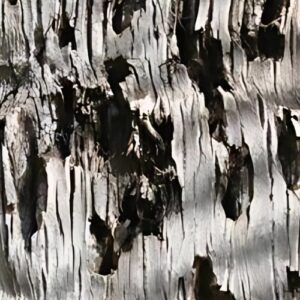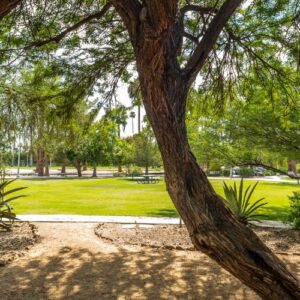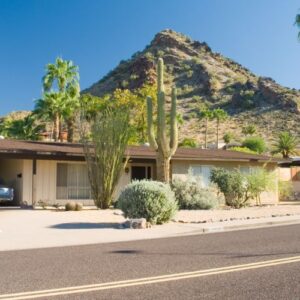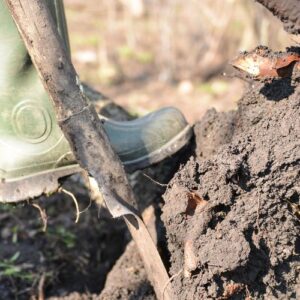
You’ve recently noticed your palo verde doesn’t quite look like it did last year at this time. Maybe there are fewer leaves in the canopy, or the bark seems darker in places. With Phoenix’s brutal summer heat, extended drought conditions, and unique pest pressures, it’s not always easy to tell if this is normal desert tree behavior or something requiring attention. Desert trees face challenges that make them vulnerable to pests and diseases, and many serious problems show subtle early warning signs that are easy to miss.
Thus, it’s important to know and recognize specific warning signs that indicate your tree is declining, helping you distinguish between typical desert tree patterns and genuine problems requiring expert diagnosis and a professional tree health assessment.
Key Takeaways
- Unusual bark changes, like dark staining or beetle galleries, indicate stress requiring professional assessment and diagnosis.
- Off-season leaf drop in desert species signals irrigation problems or pest damage needing expert evaluation.
- Root zone red flags, including buried root flares or fungal growth, point to serious stability problems.
- Progressive crown thinning differing from seasonal patterns may indicate root damage or disease.
Why Phoenix Conditions Make Tree Health Assessment Difficult
Prolonged drought, extreme heat, and alkaline soil turn minor stress into decline. These conditions can also invite bark beetles and root disease. Certified Arborists are trained to distinguish natural cycles from early decline before damage becomes irreversible.
Quick Reference: Normal vs. Concerning Tree Symptoms
Use this quick reference to identify whether your tree’s behavior is normal or concerning:
| Tree Species | Normal Seasonal Behavior | Concerning Symptoms Requiring Assessment |
|---|---|---|
| Palo Verde | Brief leaf drop in late spring (1-2 weeks); green bark year-round | Extended leaflessness beyond 2 weeks; bark darkening or cracking; sparse canopy in summer |
| Mesquite | Leafless 6-8 weeks after temperatures drop below freezing; full canopy spring-fall | Thinning canopy during growing season; one-sided leaf loss; premature leaf drop in summer |
| Citrus | Minor leaf drop during cold snaps; mostly evergreen | Excessive summer leaf drop; yellowing leaves with green veins (chlorosis); leaf curling |
| Elm | Predictable fall leaf drop; bare through winter | Early leaf drop in summer; one-sided thinning; branch dieback; sparse spring leaf-out |
| Pine | Some needle drop in fall/winter (older needles) | Yellowing or browning needles; excessive needle drop; thin canopy; holes in bark with sawdust |
| Palm | Older fronds naturally brown and drop | Crown thinning with few green fronds; sudden browning of multiple fronds; trunk soft spots |
The key difference: Normal seasonal changes happen predictably at the same time each year and affect the whole tree uniformly. Concerning symptoms appear unexpectedly, progress over time, or affect only one section of the tree.
Warning Sign #1: Bark Changes
Changes in bark appearance often signal drought stress, disease, or pest activity that requires professional evaluation. Dark stains, cracks, or small holes with sawdust at the base indicate problems beyond what homeowners can diagnose.
How to Identify Bark Problems and When to Call an Arborist
- Dark Staining and Sooty Canker: Brown or black discoloration shows fungal infection in drought-stressed trees. By the time it appears, internal decay is often advanced.
- Bark Beetles: Look for tiny holes and sawdust-like material at the base of Arizona cypress, pine, or citrus trees; all are signs of active infestation.
- Cracking, Peeling, or Cankers: Caused by sunscald, injury, or disease, especially on smooth-barked species like palo verde and citrus.
If bark changes worsen or appear with other symptoms, schedule a professional assessment. Arborists can confirm whether the issue is treatable or poses a structural risk.
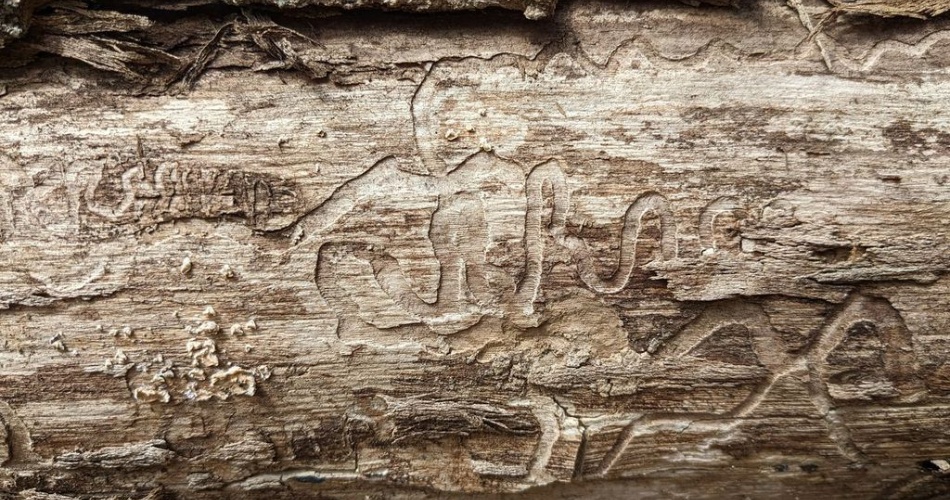
Characteristic emerald ash borer galleries carved beneath the bark, illustrating evidence of an active or past infestation in a drought-stressed desert tree.
Warning Sign #2: Unseasonal Leaf Loss
Year-round thinning, sparse canopies, or leaves only at branch tips suggest stress even when brief leaf drop is normal for desert trees.
How to Tell Normal Leaf Drop from Tree Stress
Normal patterns:
- Palo Verde: Brief leaf loss in late spring
- Mesquite: Leafless 6-8 weeks after temperatures drop below freezing
- Elm: Deciduous in fall and winter
- Citrus: Mostly evergreen, brief drop during cold snaps
Abnormal patterns include progressive or one-sided thinning, summer leaf drop on citrus, or yellowing during the growing season. These symptoms generally indicate irrigation or root-zone problems that require assessment.
How Irrigation Problems Cause Canopy Decline
Improper watering is the top cause of off-season leaf loss. Trees need deep, infrequent watering – about 2-3 times canopy width and 2-3 ft deep for mesquite, oak, and pine; and even shallower for palms and citrus. Chronic underwatering leads to thinning, while poor drainage causes root rot.
If leaf loss doesn’t fit seasonal norms, schedule a professional evaluation to pinpoint irrigation or soil issues before decline accelerates.
Warning Sign #3: Root Zone Changes
Visible changes at ground level – buried root flares, exposed roots, or standing water – often reveal hidden structural or health issues that need professional evaluation.
How to Check the Root Flare for Planting or Mulching Problems
The root flare should widen at the trunk base and be visible above soil. If the trunk looks like it goes straight into the ground, it’s buried too deep. Trees planted too deep or mulched against the trunk develop girdling roots, decay, and instability. If the flare isn’t visible, have an arborist expose it safely and correct soil or mulch depth.
How to Spot Soil and Drainage Problems Affecting Tree Roots
Poor drainage is one of the most common causes of tree decline in desert landscapes. It limits oxygen to the roots, encourages rot, and undermines stability – even in drought-tolerant species. Warning signs include:
- Standing water that pools after irrigation or rainfall
- Persistently soggy soil that stays wet for days after watering
- Erosion or exposed roots around the base of the tree
If you notice any of these conditions, schedule a professional assessment. Certified Arborists can identify the underlying drainage issues and recommend targeted solutions to protect your trees.
Warning Sign #4: Structural Changes
Visible structural problems like leaning, cracks in the trunk, or dead branches create safety hazards requiring immediate professional assessment to determine failure risk and necessary intervention.
How to Recognize Structural Problems in Your Tree
- Sudden Leaning or Tilting: Trees don’t naturally develop sudden leans. A tree that was previously upright but now tilts indicates root failure or soil movement. This is a serious safety concern requiring immediate professional evaluation.
- Trunk Cracks or Splits: Vertical cracks in the trunk, particularly if they extend through the bark into the wood, compromise structural integrity. These may result from storm damage, rapid temperature changes, or internal decay.
- Dead Branches in the Canopy: Individual dead branches are common in mature trees, but increasing numbers or large dead sections indicate serious problems. Dead branches also pose falling hazards, especially during monsoons.
When to Call an Arborist for Tree Structural Problems
You should call a Certified Arborist as soon as a tree shows signs that could compromise safety or structural stability. Certain situations demand immediate professional evaluation to prevent property damage or injury, including:
- Hazardous Trees Located Near Structures or High-Traffic Areas: Trees with structural problems near homes, patios, driveways, or sidewalks pose immediate risk. Professional assessment determines whether the tree can be made safe through cabling, bracing, and pruning, or whether removal is necessary.
- After Severe Weather: Monsoons, high winds, or heavy rains can damage tree structure or compromise roots. Even if a tree looks fine after a storm, hidden damage may exist. Post-storm assessment identifies problems before they cause failure.
- Multiple Concerning Symptoms: When your tree shows several warning signs simultaneously (bark changes plus thinning canopy plus exposed roots, for example), professional assessment becomes critical. Multiple symptoms indicate serious decline requiring expert diagnosis and treatment planning.
Why Should I Schedule a Tree Health Assessment During Fall and Winter?
Fall and winter (November through February) is the best window for tree health assessments in Phoenix. Our extreme climate accelerates tree decline in ways that don’t occur in milder climates. Record heat, extended drought, and alkaline soil all create a perfect storm of stress factors. Booking a tree health assessment in fall or winter better equips them to handle potential pest and disease issues as well as the inevitable heat stress come spring.
Frequently Asked Questions About Tree Health Assessments in Phoenix
How often should I have my Phoenix trees professionally assessed?
Healthy trees should be assessed every 2-3 years at minimum. Trees showing warning signs, located near structures, or high-value specimens need annual assessment. The ideal schedule includes a winter inspection (November-February) for overall health planning and a summer check (June-August) to monitor heat stress. Trees under stress or recovering from problems need more frequent monitoring.
What’s the difference between a tree assessment and a tree inspection?
Assessment typically means comprehensive evaluation including risk analysis, structural evaluation, and treatment recommendations. Basic inspection might be visual screening for obvious problems. Formal tree risk assessment follows ISA Best Management Practices with detailed documentation of condition, risk level, and recommended actions.
What happens if I ignore warning signs in my desert tree?
Stressed Phoenix trees often decline rapidly. They become vulnerable to bark beetles and root borers that can kill trees within a single season. Structural problems may cause failure during monsoons, risking property damage or injury. Treatment costs increase as problems progress. Early assessment allows preventive care that’s more effective and less expensive than emergency response.
Don’t Wait for Warning Signs to Become Emergencies – Schedule A Tree Health Assessment Today
Your desert trees are valuable assets that enhance your property and provide critical shade in Phoenix’s extreme climate. Fortunately, these subtle warning signs usually show up early enough for you to take action before minor problems become major crises.
Schedule your free tree health assessment with Titan Tree and take the first step in ensuring your tree’s health today. Call 623-444-8448 or request a consultation online. We serve Anthem, Tramonto, Deer Valley, Norterra, Scottsdale, and throughout North Phoenix.
See Our Latest Articles
More Articles Like This

Titan Tree Care is a full-service tree care company located in Anthem, AZ and serving all of North Phoenix. We offer a wide range of services to meet your tree care needs, including tree and palm trimming, tree pruning, tree removal, stump grinding, and more. We also offer insect or disease treatments and fertilization services. We are dedicated to providing high-quality, safe, and effective tree care services to our customers and work hard to ensure that your trees are healthy and look their best.





